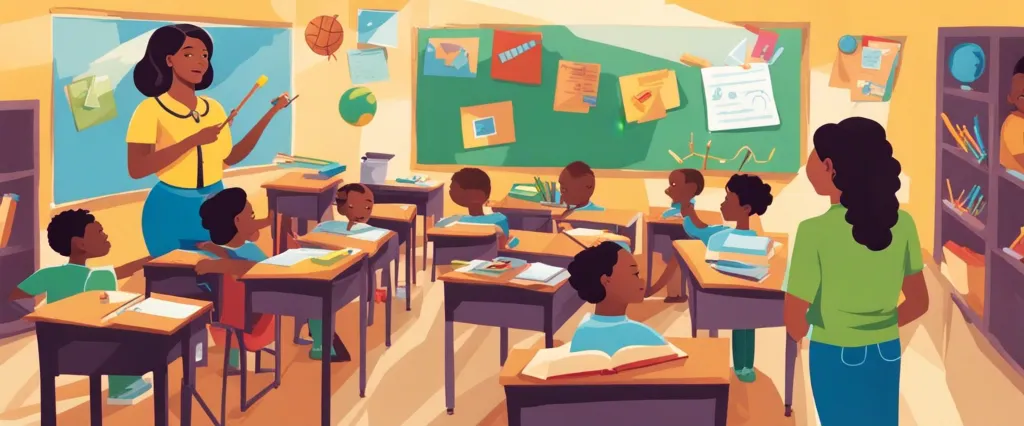——Teaching Outside the Box by LouAnne Johnson & What Our Children Teach Us by Piero Ferrucci

In the vast realm of literature dedicated to educational approaches and the profound impact they have on both students and instructors, Teaching Outside the Box by LouAnne Johnson and What Our Children Teach Us by Piero Ferrucci stand as exemplary works. These two renowned books delve into the multifaceted realm of teaching, exploring unconventional methods that transcend the boundaries of traditional education. While seemingly different in their focal points, both Johnson and Ferrucci share a common goal: to revolutionize the way we perceive education and to emphasize the transformative power of relationships within the realm of teaching and learning.
Teaching Outside the Box by LouAnne Johnson grasps the reader’s attention from the very beginning by challenging conventional teaching methods and advocating for the importance of building strong teacher-student relationships. Johnson, a former military instructor turned high school teacher, draws on her unique experiences to introduce innovative teaching techniques that engage and motivate students. By emphasizing the significance of creating a nurturing and interactive learning environment, Johnson provides a refreshing perspective on the role of educators in inspiring students’ personal and academic growth. This book promises to offer invaluable insights for educators seeking to transcend the confines of traditional education and to unleash the untapped potential within their classrooms.
On the other hand, What Our Children Teach Us by Piero Ferrucci offers a different lens through which to view education. Ferrucci, a renowned psychotherapist and educator, takes readers on a profound journey rooted in the belief that children possess innate wisdom that can remind adults of life’s most essential values. Drawing from his own experiences as a father and observations as an educator, Ferrucci intertwines personal anecdotes, scientific research, and philosophical principles to explore the reciprocal nature of teaching and learning. By advocating for a deeper understanding of children’s needs, emotions, and perspectives, Ferrucci invites readers to reconsider their roles as mentors, proving that children can indeed become our greatest teachers.
While both Teaching Outside the Box and What Our Children Teach Us present distinct yet complementary approaches to education, they share a common thread: the belief that traditional teaching models can be transformed into extraordinary avenues for growth and personal development. Johnson and Ferrucci encourage educators to step outside their comfort zones, embracing creativity, empathy, and open-mindedness to address the diverse needs of students and foster meaningful connections. This comparative study will delve into the core teachings of both books, exploring the strategies, insights, and challenges they present, ultimately shedding light on the transformative potential of education and the profound impact it can have on the lives of both teachers and learners.
Brief Summary of Two Books
Teaching Outside the Box by LouAnne Johnson
Teaching Outside the Box” by LouAnne Johnson is a practical guide for educators to transform their teaching approaches and create a more engaging and interactive classroom environment. Johnson, drawing from her own experiences as a teacher, offers innovative strategies and creative techniques to motivate students and enhance their learning experience.
The book emphasizes the importance of personalized instruction and establishing a rapport with students. Johnson advocates for teachers to adapt their lessons to students’ interests and learning styles, encouraging active participation and critical thinking. She introduces various teaching methods such as role-playing, simulations, and hands-on activities, as well as incorporating technology into the classroom to maximize student engagement.
Johnson also addresses the challenges that teachers may face, such as dealing with disruptive behavior or handling difficult students. She provides practical advice and effective classroom management techniques to create a positive learning environment where all students can thrive.
Overall, “Teaching Outside the Box” serves as a valuable resource for educators seeking to break away from traditional teaching methods and embrace innovative approaches to inspire and empower their students.
What Our Children Teach Us by Piero Ferrucci
“What Our Children Teach Us” by Piero Ferrucci is a thought-provoking book that explores the valuable lessons and insights parents can learn from their children. Ferrucci presents a holistic and compassionate approach to parenting, encouraging parents to be open to the wisdom and growth opportunities that come from their interactions with their children.
The author highlights that children have a natural ability to live in the present moment and embrace their emotions fully, a quality that adults often lose as they grow up. Ferrucci emphasizes the importance of mindfulness and being fully present for our children, as this allows us to truly understand and connect with them.
Throughout the book, Ferrucci also discusses the importance of curiosity, playfulness, and wonder, all characteristics commonly found in children. He argues that these qualities can positively affect the relationship between parent and child and enhance the parent’s own personal growth and development.
The book delves into various aspects of parenting, such as setting boundaries, disciplining with love, and fostering independence. Ferrucci emphasizes the need to strike a balance between establishing rules and allowing children to explore their own individuality.
Furthermore, Ferrucci encourages parents to learn from their children’s capacity for forgiveness and the ability to let go of grudges. He underlines the importance of practicing forgiveness in our own lives and teaching this valuable lesson to our children.
Overall, “What Our Children Teach Us” offers an insightful and reflective exploration of the lessons that can be learned from our children. It encourages parents to approach parenting with an open heart, embracing the wisdom and growth opportunities their children present.
Comparison between Two Books

Similarities in Parenting
In “Teaching Outside the Box” by LouAnne Johnson and “What Our Children Teach Us” by Piero Ferrucci, both authors touch upon various aspects of parenting. Despite the books’ primary focus on teaching and learning, they share some fundamental similarities when it comes to their insights on effective parenting. Here are the similarities about parenting found in these books:
1. Importance of empathy: Both Johnson and Ferrucci emphasize the significance of empathy in parenting. They argue that understanding and acknowledging children’s emotions, needs, and perspectives is crucial to building a strong parent-child relationship. By showing empathy, parents can create a safe and supportive environment where children feel heard and understood.
2. Individualized approach: Both authors stress the importance of recognizing the unique qualities and abilities of each child. They advocate for an individualized approach to parenting, underscoring that parenting strategies should be tailored to the specific needs and characteristics of the child. By recognizing and appreciating their children’s individuality, parents can better support them in their growth and development.
3. Balance of authority and autonomy: The books highlight the need for parents to find a balance between exercising authority and allowing children to develop their autonomy. Johnson and Ferrucci argue that parents should provide guidance and set appropriate boundaries while also giving children the freedom to explore their interests and make decisions. They emphasize that fostering independence and self-reliance in children is essential for their personal growth.
4. Communication and active listening: Both authors stress the importance of effective communication and active listening in parenting. They encourage parents to maintain open lines of communication, listen attentively to their children’s concerns, and engage in meaningful dialogue. By fostering a respectful and open communication channel, parents can nurture trust and understanding in their relationships with their children.
5. Nurturing emotional intelligence: Johnson and Ferrucci both highlight the significance of nurturing emotional intelligence in children. They argue that parents should focus not only on their children’s intellectual development but also on promoting emotional well-being. By teaching children how to recognize, understand, and manage their emotions, parents can help them navigate interpersonal relationships, develop resilience, and grow into emotionally intelligent individuals.
Overall, “Teaching Outside the Box” and “What Our Children Teach Us” share the belief that effective parenting involves empathy, individualization, a balance of authority and autonomy, effective communication, and nurturing emotional intelligence. Both books provide insights and guidance for parents seeking to create a positive and supportive environment for their children’s growth and development.
Divergences in Parenting
Teaching Outside the Box by LouAnne Johnson and What Our Children Teach Us by Piero Ferrucci are both insightful books that offer unique perspectives on education and parenting. However, when it comes to the divergence about parenting, the two books present contrasting ideas.
In Teaching Outside the Box, LouAnne Johnson primarily focuses on the role of teachers in shaping children’s education. While she acknowledges the importance of parental involvement, Johnson places more emphasis on the creative and unconventional strategies that teachers can employ to engage and inspire their students. She encourages teachers to think outside the traditional education system and use their creativity and passion to make education more meaningful for children. Therefore, Johnson’s approach to parenting is more indirect, seeing parents as partners but not the central figures in a child’s education.
On the other hand, What Our Children Teach Us by Piero Ferrucci takes a more direct approach to parenting. Ferrucci explores the invaluable life lessons that children can teach their parents and emphasizes the role of parents in guiding their children’s upbringing. He believes that children have a unique wisdom that adults can learn and benefit from. Ferrucci encourages parents to be open and attentive to their children’s needs, emotions, and perspectives, considering them as teachers who possess valuable insights. Thus, his book emphasizes the interdependent relationship between parents and children, focusing on the importance of active parenting.
The divergence in these books about parenting lies in the degree of emphasis placed on the influence of parents. While Teaching Outside the Box highlights the pivotal role of teachers in education, it somewhat downplays the direct involvement of parents. On the contrary, What Our Children Teach Us emphasizes the profound impact parents have on their children’s lives and encourages parents to actively learn from and guide their children.

Conclusion
Both “Teaching Outside the Box” by LouAnne Johnson and “What Our Children Teach Us” by Piero Ferrucci offer valuable insights into education and parenting, but the choice of which book is more worthy of reading ultimately depends on your personal interests and needs.
If you are primarily interested in innovative teaching methods and creative strategies to engage students, “Teaching Outside the Box” by LouAnne Johnson may be more beneficial. Johnson, a former high school teacher, shares her experiences and provides practical advice on how to break free from traditional teaching methods and make education more enjoyable and effective.
On the other hand, if you are interested in the emotional and personal growth that comes from raising children and learning from them, “What Our Children Teach Us” by Piero Ferrucci might be a better fit. Ferrucci, a psychotherapist, explores the profound lessons that parents can learn from their children, emphasizing the power of empathy, unconditional love, and self-discovery.
Consider your own priorities and what you hope to gain from the book. If you’re an educator looking for innovative teaching strategies, “Teaching Outside the Box” might be the better choice. However, if you are a parent seeking a deeper understanding of the lessons children can offer, “What Our Children Teach Us” could be more impactful. Ultimately, both books offer unique perspectives and valuable insights, so either choice would be worthwhile.



